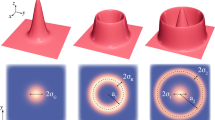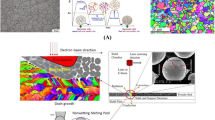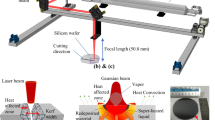Abstract
Understanding the basic action of how material removing in nanoscale is a critical issue of producing well-formed components. In order to clarify thermal effects on material removal at atomic level, molecular dynamics (MD) simulations of nanometric cutting of mono-crystalline copper are performed with Morse, EAM and Tersoff potential. The effects of cutting speed on temperature distribution are investigated. The simulation results demonstrate that the temperature distribution shows a roughly concentric shape around shear zone and a steep temperature gradient lies in diamond tool, a relative high temperature is located in shear zone and machined surface, but the highest temperature is found in chip. At a high cutting speed mode, the atoms in shear zone with high temperature implies a large stress is built up in a local region.
Similar content being viewed by others
References
Han X S, Hu Y Z. Analysis micro-mechanism of burrs formation in the case of nanometric cutting process using numerical simulation method. Sci China Ser E-Tech Sci, 2007, 50(2): 129–137
Fang Y Z, Wu F M, Zheng J J, et al. AFM research on Fe-based nanocrystal crystallization mechanism. Sci China Ser E-Tech Sci, 2008, 51(9): 46–57
Komanduri R, Chandrasekaran N, Raff L M. MD simulation of single crystal aluminum-effect of crystal orientation and direction of cutting. Wear, 2000, 242(1): 60–88
Cai M B, Li X P, Rahman M. Study of mechanism of nanoscale ductile mode cutting of silicon using molecular dynamics simulation. Int J Mach Tools Manuf, 2007, 47(1): 75–80
Maekawa K, Itoh A. Friction and tool wear in nano-scale machining-a molecular dynamics approach. Wear, 1995, 188(1): 115–122
Fang T H, Weng C I. Three-dimensional molecular dynamics analysis of processing using a pin tool on the atomic scale. Nanotechnol, 2000, 11: 148–153
Kim J D, Moon C H. A study on microcutting for the configuration of tools using molecular dynamics. J Mater Process Technol, 1996, 59(4): 309–314
Blake P N, Scattergood R O. Ductile-regime machining of germanium and silicon. J Am Ceram Soc, 1990, 73(4): 949–957
Ikawa N, Shimada S, Tanaka H, et al. An atomic analysis of nanometric chip removal as affected by tool-work interaction in diamond turining. Ann CIRP, 1991, 40(1): 29–32
Komanduri R, Chandrasekaran N, Raff L M. MD simulation of exit failure in nanometric cutting. Mater Sci Eng A, 2001, 311(1): 1–12
Pei Q X, Lu C, Lee H P. Large scale molecular dynamics study of nanometric machining of copper. Comput Mater Sci, 2007, 41(2): 177–185
Lin Y, Inamura T. Molecular dynamics simulation of ultra-micro cutting of monocrystalline silicon with the effect of air. JSME, 2006, 49(1): 70–75
Zhang L C, Tanaka H. Atomic scale deformation in silicon monocrystals induced by two-body and three-body contact sliding. Tribol Int, 1998, 31(8): 425–433
Tersoff J. Modeling solid state chemistry: Interatomic potentials for multicomponent systems. Phys Rev B, 1989, 39(8): 5566–5568
Cai M B, Li X P, Rahman M. Study of the mechanism of groove wear of the diamond tool in nanoscale ductile mode cutting of monocrystalline silicon. J Manuf Sci Eng, 2007, 129(2): 281–286
Fang F Z, Wu H, Liu Y C. Modeling and experimental investigation on nanometric cutting of monocrystalline silicon. Int J Mach Tools Manuf, 2005, 45(15): 1681–1686
Fang F Z, Wu H, Zhou W, et al. A study on mechanism of nano-cutting single crystal silicon. J Mater Process Technol, 2007, 184(1): 407–410
Daw M S, Baskes M I. Embedded-atom method: Derivation and application to impurities, surfaces, and other defects in metals. Phys Rev B, 1984, 29(12): 6443–6453
Girifalco L A, Weizer V G. Application of the Morse potential function to cubic metals. Phys Rev, 1959, 114(3): 687–690
Ye Y, Biswas R, Morris J R, et al. Molecular dynamics simulation of nanoscale machining of copper. Nanotechnol, 2003, 14: 390–396
Pei Q X, Lu C, Fang F Z, et al. Nanometric cutting of copper: A molecular dynamics study. Comput Mater Sci, 2006, 37(4): 434–441
Author information
Authors and Affiliations
Corresponding author
Rights and permissions
About this article
Cite this article
Guo, Y., Liang, Y., Chen, M. et al. Molecular dynamics simulations of thermal effects in nanometric cutting process. Sci. China Technol. Sci. 53, 870–874 (2010). https://doi.org/10.1007/s11431-009-0243-9
Received:
Accepted:
Published:
Issue Date:
DOI: https://doi.org/10.1007/s11431-009-0243-9




